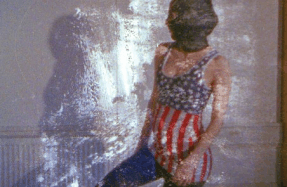Teller of Tales

To begin, a question: What exactly is La Flor?
It’s a pertinent query, albeit one with no easy answer, so let’s break it down. The first thing to know about La Flor is that, yes, it’s a 14-hour-long film—868 minutes to be exact, including intermissions and what must be a record breaking 40-minute end-credits sequence. But these talking points also obscure much of what makes Mariano Llinás’ ten-year passion project such an approachable—dare I say accessible—feat of populist filmmaking. For starters, La Flor is not a film in the traditional sense: rather, it’s a number of films, all but one of which happens to be rather traditional. Comprised of six discrete episodes, La Flor is what we might call an anthology film, in that a number of individual narratives, each working in different genre registers, have been compiled under one banner. Except that, unlike more familiar multi-director efforts, just one person is responsible for La Flor’s extraordinary stories. Add to that the actual conceit behind the endeavour—that the same four actresses would appear in different roles in each episode—and you have one of contemporary cinema’s great collaborative undertakings. Needless to say, following La Flor’s prize-winning bow in BAFICI and its bold placement in the International Competition at Locarno, its reputation precedes it.
“Some will say I reinvented the wheel. Yes, I’d say, I reinvented the wheel.”
—La Flor, Episode 4
GENRE
The first person we meet in La Flor is Llinás himself. Seated outdoors at a picnic table, leafing through a notebook and sketching the film’s flower-like symbol, he begins to describe to the viewer the film’s six-part structure and the concept behind its construction. His description sets the template in matter-of-fact fashion: over the course of 14 hours we’ll be seeing a B movie, a musical (“with a touch of mystery”), a spy movie, a remake of an old French film, and a parable about captive women in 19th-century South America. The other is difficult to describe, he says, but for the sake of brevity let’s call it a reflexive fiction (also with a touch of mystery, as it happens).
Llinás has been candid about approaching La Flor as an opportunity to learn and rediscover bygone tools and techniques, so it makes sense that he would look to genre to help facilitate the process. Key to the success of the project is his commitment to each genre—not their aesthetics, per se, but the way they operate on a formal level, and how they unconsciously reverberate in a sociohistorical context. These aren’t satirical revamps of old-timey trends: the only suggestion of irony in the film occurs when Llinás periodically appears between episodes to offer self-aware commentary. Which may explain some critics’ baffled reaction to the tone and full-tilt action-adventure machinations of much of the film’s first three episodes. After all, for all the playful digressions of Historias extraordinarias (2008), that film maintained a literary scope and imagination that signalled a clear thematic integrity. How can a mummy movie featuring a cannibalistic cat possibly be sincere?
PERFORMANCE
The four actresses enlisted to anchor this epic undertaking come from the world of Argentine theatre, and together comprise the troupe Piel de Lava. Most are relatively unknown internationally, though one, Laura Paredes, has, over the course of the film’s extended gestation, made a name for herself in the films of Matías Piñeiro. (Another Piñeiro regular, Agustina Muñoz, plays a prominent role in the spy episode.) The others, Elisa Carricajo, Pilar Gamboa, and Valeria Correa, exhibit a range and
You’re reading a preview, subscribe to read more.
Start your free 30 days





